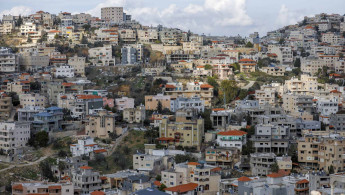Discriminatory planning policies and land grabs by Israeli authorities limit where Palestinians can live: HRW
Israel's discriminatory land policies extend beyond the occupied West Bank and besieged Gaza Strip, Human Rights Watch has said.
3 min read
Palestinian municipalities administer just three percent of all land in Israel [Getty]
Discriminatory planning policies and systemic land confiscations by Israeli authorities extend well beyond the occupied West Bank and Gaza Strip into Israel itself, Human Rights Watch said on Tuesday.
Palestinian communities in Israel have been forced to live in densely-packed towns with little room to expand their homes, HRW added.
Palestinian communities in Israel have been forced to live in densely-packed towns with little room to expand their homes, HRW added.
Israeli land policies systematically restrict Palestinians' access to land and housing, favouring the expansion of Jewish communities, the New York-based rights organistion said in a new report.
"Israeli policy on both sides of the Green Line restricts Palestinians to dense population centers while maximising the land available for Jewish communities," said Eric Goldstein, acting Middle East executive director at HRW.
Although Palestinian citizens of Israel make up 21 percent of the population, just three percent of all land in the country is estimated to fall under the jurisdiction of Palestinian municipalities, in which the majority of those citizens live.
The mass confiscation of Palestinian land began in 1948, when the state of Israel declared its independence. Much of that confiscation took place between 1949 and 1966. During this time, Palestinians in Israel lived under strict military rule with their movement severely restricted by authorities.
New laws and military regulations were also used to seize the properties and land of Palestinians who fled Israeli forces during a campaign of ethnic cleansing, including those who were displaced within the Israeli state.
Read more: For Bedouin students, the coronavirus pandemic is a stark reminder of Israel's inequality
Since 1948, Palestinian communities have been hemmed in by Israeli regulations, largely restricting the population to existing towns and villages, HRW said.
The mass confiscation of Palestinian land began in 1948, when the state of Israel declared its independence. Much of that confiscation took place between 1949 and 1966. During this time, Palestinians in Israel lived under strict military rule with their movement severely restricted by authorities.
New laws and military regulations were also used to seize the properties and land of Palestinians who fled Israeli forces during a campaign of ethnic cleansing, including those who were displaced within the Israeli state.
Read more: For Bedouin students, the coronavirus pandemic is a stark reminder of Israel's inequality
Since 1948, Palestinian communities have been hemmed in by Israeli regulations, largely restricting the population to existing towns and villages, HRW said.
Despite authorising more than 900 news "Jewish localities", the government has approved very few new Palestinian settlements.
After being brought into the centralised planning system in the 1970s, many Palestinian towns and villages have been surrounded by land zoned for uses prohibiting residential building, such as agricultural, national park or security zones.
As in the West Bank, Palestinian citizens in Israel face difficulties acquiring building permits. The Arab Center for Alternative Planning told HRW it estimates that 15 to 20 percent of homes in Palestinian towns and villages have been built without official permission, with as many as 70,000 homes at risk of demolition.
Furthermore, hundreds of towns across the country are essentially allowed to restrict Palestinian citizens from living there.
Such discriminatory regulations are against international law, HRW has said. International human rights law prohibits racial and ethnic discrimination and safeguards the right to adequate housing for all.
Read more: The day after annexation: Israel, Palestine and the one-state reality
"Israeli land policies treat towns inside its own borders in starkly unequal terms based on whether its inhabitants are Jewish or Palestinian," Goldstein said. "After decades of confiscating Palestinians' land, Israel confines them to crowded towns while enabling neighboring Jewish towns that exclude them to flourish."
The Israel Planning Administration (IPA) has rejected the rights organisation's contention that "Israeli policy restricts and confines Arab towns and villages".
The IPA has "put a great deal of effort into planning through the entire hierarchy of planning institutions in order to advance and strengthen Arab communities", it claimed in a March letter to HRW.
The planning authority added it had "legalised thousands of existing housing units".
Follow us on Facebook, Twitter and Instagram to stay connected





 Follow the Middle East's top stories in English at The New Arab on Google News
Follow the Middle East's top stories in English at The New Arab on Google News
![Netanyahu furiously denounced the ICC [Getty]](/sites/default/files/styles/image_330x185/public/2024-11/GettyImages-2169352575.jpg?h=199d8c1f&itok=-vRiruf5)
![Both Hamas and the Palestinian Authority welcomed the ICC arrest warrants [Getty]](/sites/default/files/styles/image_330x185/public/2024-11/GettyImages-2178351173.jpg?h=199d8c1f&itok=TV858iVg)
